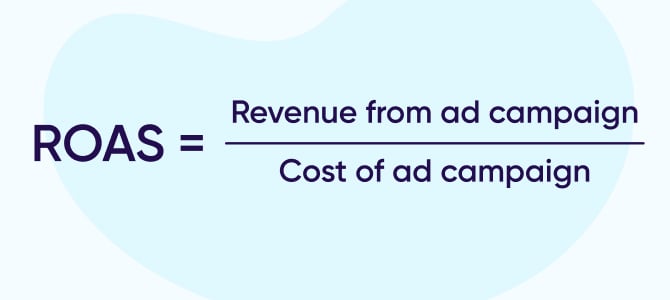First of all – yes, the title is a bit hyperbolic on purpose. There are several important marketing metrics and KPIs you should pay attention to when it comes to paid media campaigns. However, everything we do as strategists and tacticians comes down to one final point: are these campaigns driving revenue and profit?
I’ve been a paid media marketer for more than a dozen years now. I’ve worked with many clients across all different types of industries and verticals. Each of these clients had different strengths, weaknesses, strategic awareness, and tactical needs. But every single one of them had the same ultimate goal of using paid media campaigns to make money at profitable rates.
When it comes to ensuring the work you do meets that ultimate goal, there is one metric that you must hold above all others: Return on Ad Spend (ROAS).
In this post, you’ll learn the basics of ROAS, the benefits and challenges of using ROAS as your primary KPI, and tips for increasing your ROAS levels in your own paid media accounts.
What Is Return on Ad Spend (ROAS)?
The formula for calculating Return on Ad Spend is simple:
For example, if you have a paid search campaign that has spent $1,000 and you’ve acquired $3,000 worth of revenue from that same campaign, your ROAS would be 300% or 3.0 (as in 3:1) because $3,000 revenue / $1,000 cost = 3.0 (or 300%).
Why Is ROAS Important?
ROAS is the primary metric you want to use to gauge how effective and efficient your campaigns are at generating revenue for your business. After all, generating revenue is what keeps your business going.
How Does ROAS Compare to Other Marketing Metrics?
While other conversion-based metrics such as conversion rate (CVR) and cost per acquisition (CPA) can give you some insight into your campaigns’ effectiveness at driving leads or sales, they do not give you any insight into revenue or profitability. And, at the end of the day, it all comes down to the money.
Here’s an example of why ROAS is superior to other conversion-based metrics – let’s say you have two campaigns that have the following metrics:
| Campaign | Cost | Clicks | Conversions | CPA | CVR | Revenue | ROAS |
|---|---|---|---|---|---|---|---|
| A | $1,000 | 150 | 50 | $20.00 | 33.3% | $7,500 | 750% |
| B | $1,000 | 100 | 30 | $33.33 | 30.0% | $8,000 | 800% |
If you only look at CPA or CVR, you would jump to the conclusion that campaign A is more efficient and effective for your business. However, once you factor in how much revenue each campaign is driving, you see campaign B is actually acquiring more valuable conversions and has a better ROAS. Instead of pushing more money into campaign A, this data suggests you would want to invest more in campaign B first.
What’s a Good ROAS?
A good ROAS is whatever percent allows you to be profitable and sustain (or even grow) your media investment and your business as a whole.
If you sell a product or service with small profit margins, you’ll need to aim for a high ROAS level well above 100% (say 500%, 700%, or maybe even 1000%). If, however, you make a large profit margin on any conversion you drive, you can probably consider a ROAS level closer to 150% or 200% as “good.”
I’m going to expand more on how you figure out exactly what ROAS level you should be aiming for below. But first, we need to talk about profitability and Return on Investment.
Return on Investment (ROI) looks at net profit versus total investment, whereas Return on Ad Spend (ROAS) looks strictly at revenue and media cost. To give you an idea of how these metrics can vary for the same campaign, here’s a hypothetical example of a paid search account selling products via e-commerce:
Media Spend: $10,000
Revenue Generated: $50,000
Profit Margin on Products Sold: 25%
ROI = ($50,000 revenue x 0.25 profit margin) / $10,000 cost = 125%
ROAS = $50,000 revenue / $10,000 cost = 500%
ROI is a crucial metric when analyzing profitability, but it factors in components (such as the profit margin of a given product) that aren’t impacted directly by paid media campaigns. Thus, when evaluating your digital marketing strategy or what tactics you’re using, ROAS is the truer metric to use.
Breakeven ROAS
While you don’t necessarily want to let business expenses outside of your paid media efforts impact your judgment of success or failure for any particular campaign, it is good to know at what ROAS level you stop being profitable and start losing money. Using the same details as the hypothetical above, let’s calculate what the breakeven ROAS for that paid search account would be:
Media Spend: $10,000
Revenue Generated: $50,000
Profit Margin on Products Sold: 25%
Breakeven ROI = 100% (by definition)
Breakeven ROI: ($Y revenue x 0.25 profit margin) / $10,000 cost = 100%
Y = $40,000 revenue
Therefore, Breakeven ROAS: $40,000 revenue / $10,000 cost = 400%
In this case, this advertiser’s paid search account needs to have a ROAS of 400% or more to break even and begin making a profit. This advertiser should, therefore, aim to acquire a ROAS over 400% for it to be considered “good.”
What’s a Target ROAS?
A Target ROAS is simply a ROAS level you set as a goal for a campaign. Once you’ve determined what your breakeven ROAS is, you can aim for a desired ROAS target for an entire account. To do this, you can evaluate each campaign you’re running individually (or sets of campaigns, if you choose to) and set an individual Target ROAS level using automated bidding strategies in your paid media platform.
For example, you can set a Target ROAS while using Maximize Conversion Value automated bidding in Google Ads. These Target ROAS levels are used by your paid media platforms as part of their bidding algorithms in an effort to generate ad impressions and acquire ad clicks from the right users who are more likely to generate revenue at appropriate costs.
Benefits of ROAS
Using ROAS as your primary KPI makes prioritizing and optimizing your campaigns more straightforward.
Do you see a campaign generating a high ROAS level that’s currently being limited by budget? Increase the daily budget. You just identified and made an adjustment in seconds that should, in all likelihood, generate more sales and revenue at profitable costs.
Do you see a campaign generating a relatively high amount of clicks and spending a noticeable amount of money without producing an acceptable ROAS level? Dig in and see what keywords and search terms are costing you too much money. You identified a potential problem quickly just by referencing a campaign’s ROAS level.
Without ROAS, identifying the adjustments for these campaigns would be more time-consuming and convoluted. Again, other conversion metrics like CVR and CPA are helpful! But they often don’t tell a detailed story regarding your bottom line, which is necessary when making optimizations in your account.
Challenges of ROAS
The challenge with using ROAS as your primary KPI is that it’s not a “set it and forget it” tactic, nor is it a “one size fits all” strategy.
Not every campaign you run will or should have the same Target ROAS level. For instance, in a paid search account, you might have a set of campaigns that convert really well and typically generate an efficient ROAS level. You’d likely want to set a fairly high Target ROAS level in these campaigns as you can rely on them generating the results you’re looking for in terms of both revenue volume and ROAS.
Likewise, you might have a set of campaigns that convert efficiently but have far more expensive click costs and, thus, lower ROAS levels compared to other campaigns. While these campaigns generate desired sales and revenue levels for your business, you’d likely want to set lower Target ROAS levels for these campaigns as they’re more competitive. Setting a Target ROAS level too high for these campaigns might cause impressions (and clicks, sales, revenue, etc.) to drop off significantly as your platform determines it isn’t able to keep up with your competitors while attaining the desired ROAS levels you specify.
While ROAS gives you context about your campaigns’ efficiency at acquiring revenue, it doesn’t guarantee any particular level of revenue volume. You need to continually evaluate and adjust your campaigns to keep up with what’s happening in your market.
3 Tips to Increase Your ROAS
Now that you have a clear understanding of what ROAS and why it’s important, let’s look at some concrete ways that you can improve your ROAS.
1. Assign Values to Your Conversions
Ensure all the conversions you’re using and optimizing toward have value data associated with them. For e-commerce accounts, this is a given because any transactions you have that register as conversions in your platform should dynamically populate revenue data. However, for lead-based accounts, it’s not as straightforward.
For businesses that have a robust CRM with accurate lead and revenue data associated with their customers, you often have the opportunity to import offline value data into your paid media platform via an API connection. These connectors use an identifier, such as a click ID from Google Ads or Microsoft Advertising, to link any values data housed in your CRM associated with a given user with the conversion(s) they trigger in your platform.
If you’re eligible to use this type of API connection, this makes associating value with your conversions easy. If you aren’t able to use an API connection, but you have the necessary value data in your CRM, you can still automate offline conversion tracking (it’s just a manual process to set up).
If automating offline conversion tracking just isn’t a feasible solution, you can still calculate how valuable each of your conversions is and manually assign static values to them. That way, your platform can tell that a form-fill conversion is more or less valuable than a click-to-call conversion and can use that data effectively. You’ll need accurate data on your conversion funnel to do this.
For example:
Platform Conversion = Form Fill
CRM Data:
- Form Fills convert to sales at a 10% rate (e.g. 10 form fills per sale)
- Sales are worth $2,500 on average
Therefore, average value per form fill = $250 (10% of $2,500)
2. Use Automated Value-Based Bidding
Once you have conversion value data for everything you’re including in your conversion metric and optimizing toward, you’ll be able to use automated value-based bidding strategies such as Maximize Conversion Value or Target ROAS. These are part of many paid media platforms but can only be utilized effectively if you have accurate (or at least relevant) value data associated with your conversion actions.
Using these automated bidding options will make your life as a paid media advertiser much simpler. Instead of doing manual calculations in a spreadsheet or changing manual bids one by one, you can just tell any campaign to “do its thing” and try to hit a certain ROAS level or maximize ROAS given your campaign’s daily budget. It’s a massive time-saver and frees you up to focus on other strategic items versus being bogged down in the minutia of manual optimization.
Pivot to a ROAS-First Strategy When the Market Contracts
If the vertical you’re advertising in is experiencing a contraction or being affected by an economic recession, it’s crucial you use ROAS to your advantage to stay above your competitors as best you can, even if you don’t have the biggest budgets.
Using ROAS as your primary KPI when you know impressions, clicks, and sales are on the decline will allow you to focus your media investment on the most profitable campaigns first and foremost. You can then prioritize where to invest any remaining budget after maxing out campaigns that are giving you the most revenue at the best return possible.
Wrap Up
If you’re not using ROAS in your paid media platforms already, you should absolutely do that as soon as possible. Preferably yesterday. You should assume your competitors are doing the same. You’re putting your business at a disadvantage by not utilizing ROAS effectively.
If you’re just getting started with using ROAS, use the information above to calculate your breakeven point and figure out what the right ROAS levels should be for each of your paid media campaigns. Once that’s done, use the tips I provided in this post to give yourself as much advantage as possible when using ROAS in your accounts.
As markets and economic trends shift over time, ROAS will continue to be a vital metric that may determine whether or not using paid media accounts as entire advertising channels for your business succeeds or fails. Don’t ignore ROAS – use it with confidence and drive results for your bottom line!
The post What Is ROAS & Why It’s the Only Marketing Metric You Should Care About appeared first on Portent.




